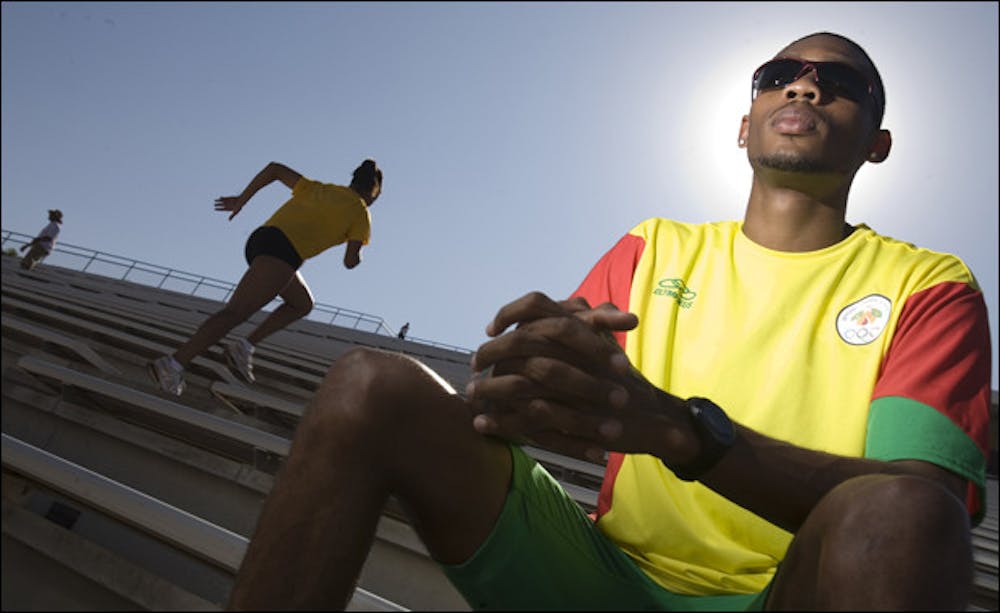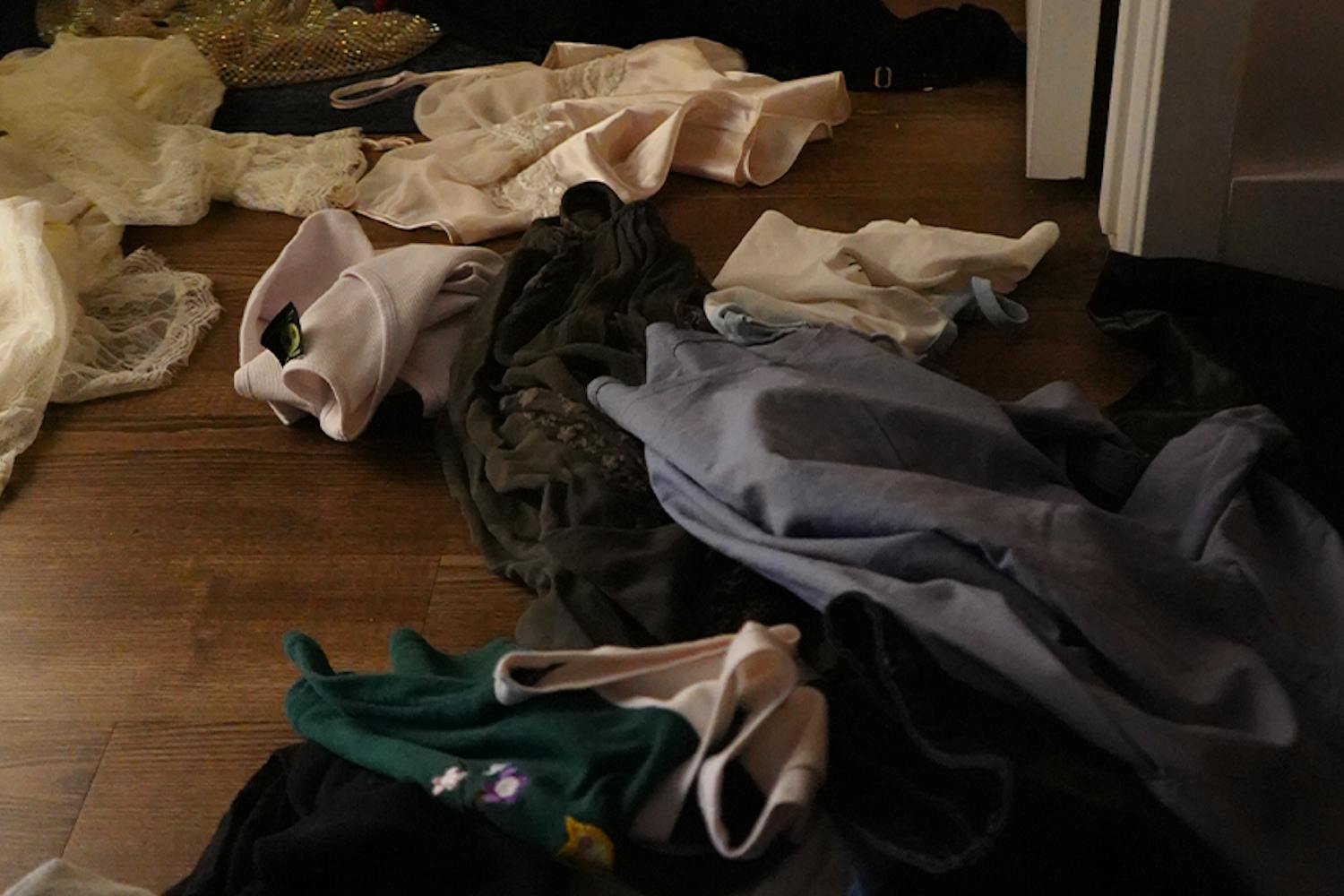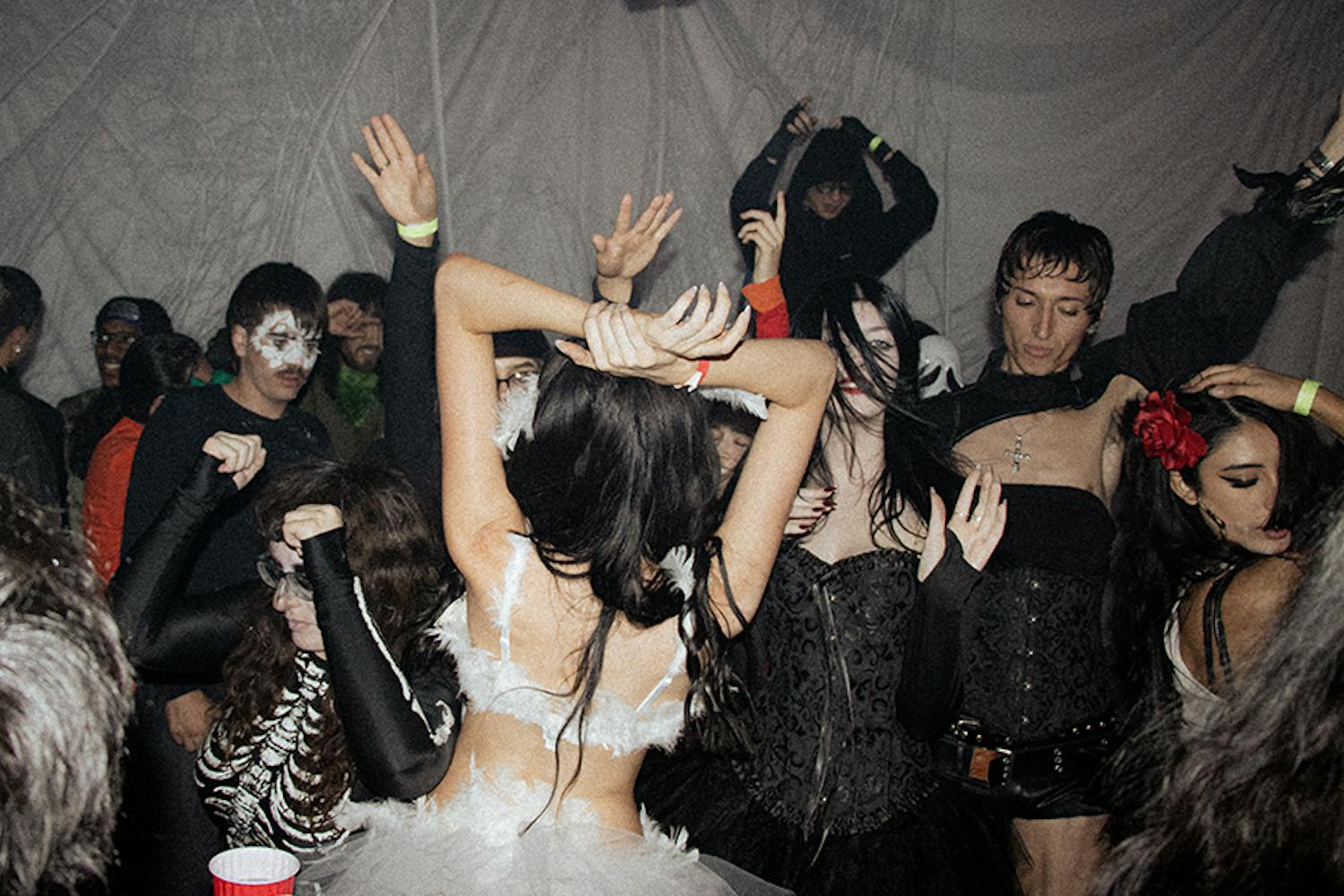::Read about the eco-friendly Beijing stadium by clicking here.::
Qualifying for the Olympics is a goal many athletes dream of achieving, but for some who represent ASU, that dream became a reality in 2008.
With 11 athletes and five coaches and trainers from ASU’s past and present, Sun Devils from all generations were represented in Beijing.
On top of the typical college student and employee roles, the participants went above and beyond by representing their home countries on the world’s finest stage.
It takes four years to bring the world together for only 17 days, but in that time people shed their differences and celebrated each other’s achievements and hard work.
New bonds between citizens from different countries were made, and old friendships were rejuvenated.
Sacrifice was the ultimate price to pay for a chance to compete, but the road to Beijing proved to be unforgettable and worth every struggle for these ASU affiliates.
Here’s a look into the lives of some of the athletes and coaches who traveled to Beijing and back.
JOEL PHILLIP
Originally from the country of Grenada, interdisciplinary studies senior Joel Phillip came to the United States for his college education and for the opportunity to perfect his sport, track and field.
According to the Grenada Guide Web site, the country is made up of three islands located in the Eastern Caribbean. It is 133 square miles and has a population of around 90,000 people.
“The only university in Grenada is a medical university,” Phillip says. “And basically their resources for track and field are limited.
“[Grenada] doesn’t have big enough weight rooms or up-to-date equipment, and there is only one paved track in the entire country,” he says. “You are limited to the level of practice you can do. There’s only so far you can go while in Grenada”
But in order to come to America, Phillip had to make the ultimate sacrifice. He had to leave his family and childhood friends behind in order to propel himself forward.
With Grenada being such a small country, coming to the U.S. and ASU has greatly expanded Phillip’s opportunities to improve on the track and off, he says.
ASU’s advanced workout facilities and track have helped Phillip to train and progress in an efficient environment. The differences in the American culture have broadened his outlook on the way the world works by showing him how other people live, he says.
“It was kind of hard to adjust after moving here because the way of life and the weather are different than Grenada,” Phillip says.
“[In Grenada] things are not as fast paced, and it is more laid back and relaxing,” he says. “You can go to school or work and then just walk straight to the beach and relax.”
Phillip came to the U.S. at the age of 17 and originally attended Central Arizona College, but for the fall semester of 2007 he received a full scholarship to ASU for his exceptional athletic ability as a decathlete and 400-meter hurdle runner.
Once he arrived, however, Phillip quickly swapped the decathlon for the 400-meter dash — a decision that would set the foundation for his route to the Olympics.
“Honestly, I didn’t mind switching to the 400 because, before I got to the U.S., that was my main event in high school. I enjoyed doing it the most because it was the first event I ever competed in when I started running,” Phillip says.
Knowing that the Olympics would take place in August 2008, Phillip had only one year to prepare for the event, so he started as soon as school did.
For his typical training, he practices Monday through Friday for about 45 to 90 minutes a day, dividing his week between working out in the weight room and on the track.
In the fall, he practices strength training, in the spring he works on his speed, and all year he works to improve his endurance, he says.
“It’s more than just running down the track fast. It has to do with proper form, proper movement, proper leg and arm coordination and the rhythm of your stride,” Phillip says.
Phillip qualified for the 2008 Olympics while competing in ASU’s Sun Angel Track Classic meet in April 2008. He ran the 400-meter dash in 45.34 seconds, just a few tenths of a second under the Olympic qualifying standard of 45.60.
Athletes are constantly training and working to perfect their sport, so when it came to the Olympics, Phillip didn’t have to do much to improve upon his training. Instead, he focused on keeping up his disciplined mentality, he says.
But no matter how disciplined, college’s temptations can work against an athlete.
In order to balance his schedule between work and school, Phillip usually takes 12 credit hours a semester.
“With 12 credits I’m able to handle the stress of school and practice, and I’m able to manage my everyday life,” Phillip says.
Along with school work, managing a healthy diet and getting the right amount of sleep can also be affected by college life.
Like many students, Phillip generally eats whatever he can get. He doesn’t necessarily follow a strict diet, but he tries to maintain a healthy regimen. If he has time in the morning for breakfast, he’ll eat cereal or toast; at lunch he grabs pasta or a sub-sandwich; and for dinner he usually eats chicken or fish with rice and vegetables.
“While in college, it’s kind of hard to stay on track because sometimes you feel the need for junk, but you just have to remember what you want to accomplish, and you have to eat right.”
Even though track and field dictates many of Phillip’s day-to-day decisions, he doesn’t feel like he has to compromise anything for the sport.
“I’ve been in track and field so long, it’s just become a part of my life,” he says. “Most of the friends I have run track, so I’ve never really had to miss out on any social things.”
But where does someone so dedicated draw the line between work and play? The weekends, something every student looks forward to, serve as a temporary outlet to relieve stress and let loose.
Hanging out with friends, playing video games and going to the movies help to keep Phillip grounded and living like any other college student.
However, when Beijing is calling, any athlete would ditch the simple pleasures of everyday life for the chance to compete among the best from around the world. In return, the city would not disappoint.
“[Beijing] was huge and different,” Phillip says. Along with culture, architecture served as the biggest difference for Phillip. “[The structures] are more abstract, and looked like pieces of artwork rather than actual buildings,” he says.
Not only were the buildings created for the Olympics different, offices and even some of the apartment complexes were also very modern and colorful, he says.
“All down the street you could see a variety of different colors and shapes on buildings, billboards and posters,” he says.
But for Phillip, the beauty and uniqueness of Beijing couldn’t compare to the experience of participating in his first Olympics.
The moment he took his place on the track in front of his starting blocks is a moment that will be forever engrained in his memory.
The runners had to walk through what seemed like a tunnel in order to get to the track in the center of the stadium, Phillip says.
“As I walked through, I could only see a section of the stadium, and I wasn’t nervous because it just reminded me of past meets I’ve competed in,” he says. “But when I got to the end and walked on the track and looked out… I got really nervous, especially when the crowd started cheering and clapping. You could hear and feel the vibration
“I wasn’t distracted by it, but it was surprising to see that many people in one venue,” he says.
Phillip didn’t qualify for the finals, but overall he placed 26 out of 34 runners with a time of 46.30.
All in all, Phillip says he felt the experience taught him lessons that will help him to improve for the next Olympic Games.
“Being in Beijing, I learned a lot of stuff from world class athletes,” Phillip says. “I know now I just have to be a lot more relaxed when competing at meets. And I’ve also learned to just be myself and to put a little bit more effort into my practice.”
With an ever-growing appreciation for track, Phillip says his passion for what he does continues to develop because of the one event that originally drove him to compete, the Olympics.
After qualifying for the 2008 Olympics and competing in Beijing for Grenada, it’s obvious his hard work and dedication paid off.
He has been running around a track since the age of thirteen, and has never questioned his drive or where it was taking him.
“When I ran track in high school at Grenada, my coach told me about my potential to make it to the Olympics,” Phillip says. “I carried that with me up until now.”
MOHAMMED MADWA
Mohammed Madwa, a communications senior, began swimming at the age of nine in his home country of Kuwait.
“My mom really wanted me to be on a swimming team,” Madwa says. “It was considered to be the healthiest sport. There was less injury compared to other sports and it was something to keep me engaged and active.”
But little did he know his mother’s influence would lead him to become the first swimmer in Kuwait’s history to qualify for the Olympic Games.
“When I was younger, I didn’t think about the Olympics, and I didn’t realize how big of a deal they were,” Madwa says. “I was pretty much just having fun.”
At the age of 13, Madwa was approached by his Kuwaiti swimming federation and was given the option to move to the U.S. to improve his swimming ability and education, he says.
He accepted the offer and decided to take his 100-meter freestyle to America. Leaving his family and childhood behind, Madwa moved to Florida with a legal guardian by his side, he says.
“It was really hard because of the language. ‘Yes’ and ‘no’ were the only things I knew,” Madwa says.
“I basically had two years to learn [English] and adjust to the American culture before I got thrown into it,” he says. “At that point, I had no option but to communicate in English.”
Madwa’s first actual high school class was an SAT preparation course where he was introduced to “intense vocabulary” before he was able to learn the basics, he says.
At 16, Madwa’s legal guardian set him up in an apartment with other swimmers on his club team. The swimmers were provided with transportation that would take them to school and practice, but officially, they were “on their own,” Madwa says.
“It was really hard because I can get really homesick,” he says.
Madwa only gets to go back to Kuwait and visit his family once or twice a year for less than a week at a time because of his international meet commitments to his federation, he says.
“Every year I get recalled by my federation for the Kuwaiti national team so that I can compete with them,” he says. “Then, I get to see my family for maybe four or five days before I come back to the U.S.”
College, however, would ease Madwa’s discomfort with being away from home for so long.
While competing in a routine swim meet, Madwa met an ASU swimmer who introduced him to the university’s program. Madwa immediately became interested in ASU, and after he graduated high school, he decided to join the Maroon and Gold team, he says.
Madwa even turned down a full-ride scholarship to the University of Tennessee in order to move to Arizona.
“ASU had a more exciting environment surrounding it,” Madwa says.
“But one of my main reasons for moving to Arizona was because it reminded me of home. The whether in Kuwait is similar, and it is just as hot as here.”
After joining ASU and its swimming team, Madwa became really impressed with how they trained. Compared to Florida, ASU’s advanced facilities and coaches provided for a quality workout, he says.
The environment helped Madwa get used to swimming in the dry heat, and he enjoyed being able to practice in an outdoor pool, he says.
For a typical routine, Madwa practices nine sessions a week, two hours a session, totaling 18 hours of devotion. On top of that, he takes around 12 credit hours a semester.
Madwa spent his college years perfecting his 50-meter freestyle for the 2008 Olympics in Beijing. With a swimming time two tenths away from the qualification standard for the 2004 Olympics, he knew making it in 2008 was nothing far from his reach.
“It wasn’t until I was so close to making it in 2004 I actually thought about the possibility of me being a part of it,” he says. “I just remember thinking ‘wow, to be there as an athlete and to represent Kuwait would be such an honor.’”
It wasn’t long before his hard work paid off and the Olympics came knocking at his door with an invitation in hand.
To prepare for his first Olympics, his training doubled and his nutrition and sleep became top priorities, Madwa says.
For food, he usually cooks at home and sticks to fruits and salads on a regular basis. In fact, he says his only major indulgence is Subway.
As far as sleep goes, Madwa says because his Olympic training was so difficult, all he wanted to do during his free time was catch up on some Z’s.
“Going out and doing other things would compromise my rest,” Madwa says. “I was pretty much an indoor person on the weekends while training.”
But once Madwa arrived in Beijing, it was easy for him to see that the uphill struggle of balancing life and training was well worth it.
China did a lot to accommodate Olympians and foreigners. The transportation, facilities, and people all created a welcoming environment for the athletes.
To help with traffic, the government designated a special lane on their public roads and freeways for those involved in the Olympics and their exclusive use only, Madwa says. It basically started from the airport and went all the way around the city, and any public interference would be penalized with a ticket or citation, he says.
The facilities were also impressive.
“The pool was one of the most amazing sites I’ve ever seen in my life,” Madwa says.
“It was designed in a way to maintain a quality temperature and environment that would maximize the swimmers’ performance and the overall competition.”
With a state-of-the-art venue to swim in, Madwa finished 45 out of 96 in his race with a time of 22.83 — his personal best.
The people of China helped to make the event a special one because of their genuine interest in the Olympics and the people involved, he says.
“I only went out once to explore Beijing, and when I did, all the Chinese people would point at me and come up to me wanting to take pictures and get signatures, and they would ask me for a pin,” he says.
Each athlete was given pins with either their country’s logo on it or the Olympic emblem, Madwa says. The pins were traded among athletes from different countries, and they represented new friendships and acquaintances.
“I met a lot of people at the Olympics, and I made new friendships with swimmers from Barbados, Singapore and Hong Kong,” Madwa says. “I also got to catch up with swimmers I had competed against in previous meets.”
Madwa may have not come home with a medal, but he made it back to the states with a few new friends, a few learned lessons and a stronger determination for the 2012 games.
“From this experience I realized it’s not just training that makes you strong. It’s also about sleeping, eating healthy, staying hydrated, keeping your mind positive and maintaining a competitive attitude,” Madwa says.
Madwa plans to graduate from ASU in May of 2009, but he says he’s not planning on graduating from swimming anytime soon.
“I think I’ll be swimming for a while. Every time I compete and swim my best time I feel really motivated to keep going,” he says. “Once I can’t improve anymore, I’ll call it a retirement.”
COACH MIKE CHASSON AND COACH MARK BRADSHAW
Athletes may receive most of the praise and glory from spectators when it comes to the Olympics, but they owe some credit to the coaches and trainers who helped them get there.
ASU’s head swimming coach Mike Chasson and head diving coach Mark Bradshaw were both given the privilege to train their ASU athletes for the 2008 Olympics.
“The Olympics is such a fantastic experience,” Chasson says. “There’s a positive energy that makes you feel good, and everyone is happy and excited to be there and wants to compete.”
The Kuwait Federation invited Chasson to go as Mohammed Madwa’s coach, making 2008 Chasson’s sixth Olympics since 1984.
For Bradshaw, this was his third Olympics. Bradshaw was asked by the Finland Federation to coach and train Joona Puhakka, a former ASU diver.
Coaching is a job that proves fun and hard work go hand-in-hand, but the lifestyle requires plenty of sacrifices many people would not be able to endure.
Overall, the job can be extremely time-consuming and coaches can’t afford to worry about hours, Chasson says. Many work anywhere from 40 to 80 hours a week.
“If something has to be done on a Sunday, you do it. If something has to be done on a holiday, you do it,” Chasson says.
Along with time, constant traveling and being away from one’s family, can also be difficult to manage.
“It’s definitely a certain lifestyle, and you have to really want to do it,” Bradshaw says. “But I just enjoy the heck out of helping my athletes with their careers. It may be a grind sometimes, but it’s worth it.”
The coaches especially found the Olympics in Beijing to be worth the struggle.
In comparison to others, Chasson says the recent Olympics were by far the best he had ever attended.
“The organization level at the Beijing Olympics was the highest I’ve seen,” he says. “It was very well run, and very well done. The Chinese did a very good job.”
The citizens of Beijing also added to the excitement with their friendly demeanor and genuine curiosity towards those involved with the Olympics. The people went out of their way to help foreigners when they needed it, and they also seemed really pleased with having The Games in their country, Bradshaw says.
From the progressive facilities, to the kind people, to all of the measures taken to ensure a successful event, the 2008 Olympics surpassed all expectations and raised the bar for the future, Chasson says.
Aside from the prestige and the momentous events, coaching is genuinely about passion, Chasson says. With it, coaches and trainers are able to pass along their love for a sport to those just getting their start.
“I really enjoy the teaching part of what I do,” Bradshaw says. “I try to share my past experiences with athletes to help them achieve their goals.”
Reach the reporter at smalekoo@asu.edu.




